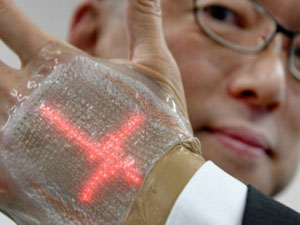



Date:19/02/18
 Palm reading could take on a whole new meaning thanks to a new invention from Japan: an ultrathin display and monitor that can be stuck directly to the body.
Palm reading could take on a whole new meaning thanks to a new invention from Japan: an ultrathin display and monitor that can be stuck directly to the body.
The band-aid-like device is just 1mm thick and can monitor important health data, as well as send and receive messages, including emojis.
Takao Someya, the University of Tokyo professor who developed the device, envisions it as a boon for medical professionals with bedridden or far-flung patients, as well as family living far from their relatives.
“With this, even in home-care settings, you can achieve seamless sharing of medical data with your home doctors, who then would be able to communicate back to their patients,” he said.
Slapped onto the palm or back of a hand, it could flash reminders to patients to take their medicine, or even allow far-away grandchildren to communicate with their grandparents.
“Place displays on your skin, and you would feel as if it is part of your body. When you have messages sent to your hand, you would feel emotional closeness to the sender,” Someya said.
“I think a grandfather who receives a message saying ‘I love you’ from his grandchild, they would feel the warmth, too,” he said.
The invention could prove particularly useful in Japan, with its rapidly aging population, replacing the need for in-person checks by offering continuous, non-invasive monitoring of the sick and frail, Someya said.
The display consists of a 16-by-24 array of micro LEDs and stretchable wiring mounted on a rubber sheet.
It also incorporates a lightweight sensor composed of a breathable “nanomesh” electrode and a wireless communication module.
“Because this device can stretch, we now can paste a display on things with complex shapes, like skin,” Someya said.
It can be placed on the human body for a week without causing skin inflammation and is light enough that users might eventually even forget they are wearing it.
Along with medical applications, Someya hopes the device could eventually lead to wearable displays for joggers to monitor heart rates or check running routes.
He imagines workers using the displays to consult manuals on their arms while working.
Someya created the device in partnership with Japanese printing giant Dai Nippon Printing, which hopes to put it on the market within three years.
Japan develops ultrathin elastic display
 Palm reading could take on a whole new meaning thanks to a new invention from Japan: an ultrathin display and monitor that can be stuck directly to the body.
Palm reading could take on a whole new meaning thanks to a new invention from Japan: an ultrathin display and monitor that can be stuck directly to the body.The band-aid-like device is just 1mm thick and can monitor important health data, as well as send and receive messages, including emojis.
Takao Someya, the University of Tokyo professor who developed the device, envisions it as a boon for medical professionals with bedridden or far-flung patients, as well as family living far from their relatives.
“With this, even in home-care settings, you can achieve seamless sharing of medical data with your home doctors, who then would be able to communicate back to their patients,” he said.
Slapped onto the palm or back of a hand, it could flash reminders to patients to take their medicine, or even allow far-away grandchildren to communicate with their grandparents.
“Place displays on your skin, and you would feel as if it is part of your body. When you have messages sent to your hand, you would feel emotional closeness to the sender,” Someya said.
“I think a grandfather who receives a message saying ‘I love you’ from his grandchild, they would feel the warmth, too,” he said.
The invention could prove particularly useful in Japan, with its rapidly aging population, replacing the need for in-person checks by offering continuous, non-invasive monitoring of the sick and frail, Someya said.
The display consists of a 16-by-24 array of micro LEDs and stretchable wiring mounted on a rubber sheet.
It also incorporates a lightweight sensor composed of a breathable “nanomesh” electrode and a wireless communication module.
“Because this device can stretch, we now can paste a display on things with complex shapes, like skin,” Someya said.
It can be placed on the human body for a week without causing skin inflammation and is light enough that users might eventually even forget they are wearing it.
Along with medical applications, Someya hopes the device could eventually lead to wearable displays for joggers to monitor heart rates or check running routes.
He imagines workers using the displays to consult manuals on their arms while working.
Someya created the device in partnership with Japanese printing giant Dai Nippon Printing, which hopes to put it on the market within three years.
Views: 700
©ictnews.az. All rights reserved.Similar news
- The mobile sector continues its lead
- Facebook counted 600 million active users
- Cell phone testing laboratory is planned to be built in Azerbaijan
- Tablets and riders outfitted quickly with 3G/4G modems
- The number of digital TV channels will double to 24 units
- Tax proposal in China gets massive online feedback
- Malaysia to implement biometric system at all entry points
- Korea to build Green Technology Centre
- Cisco Poised to Help China Keep an Eye on Its Citizens
- 3G speed in Azerbaijan is higher than in UK
- Government of Canada Announces Investment in Green Innovation for Canada
- Electric cars in Azerbaijan
- Dominican Republic Govt Issues Cashless Benefits
- Spain raises €1.65bn from spectrum auction
- Camden Council boosts mobile security





















